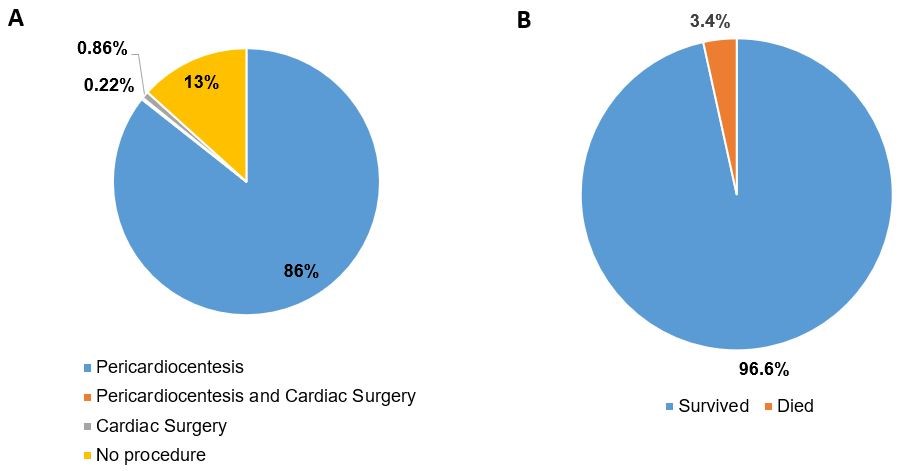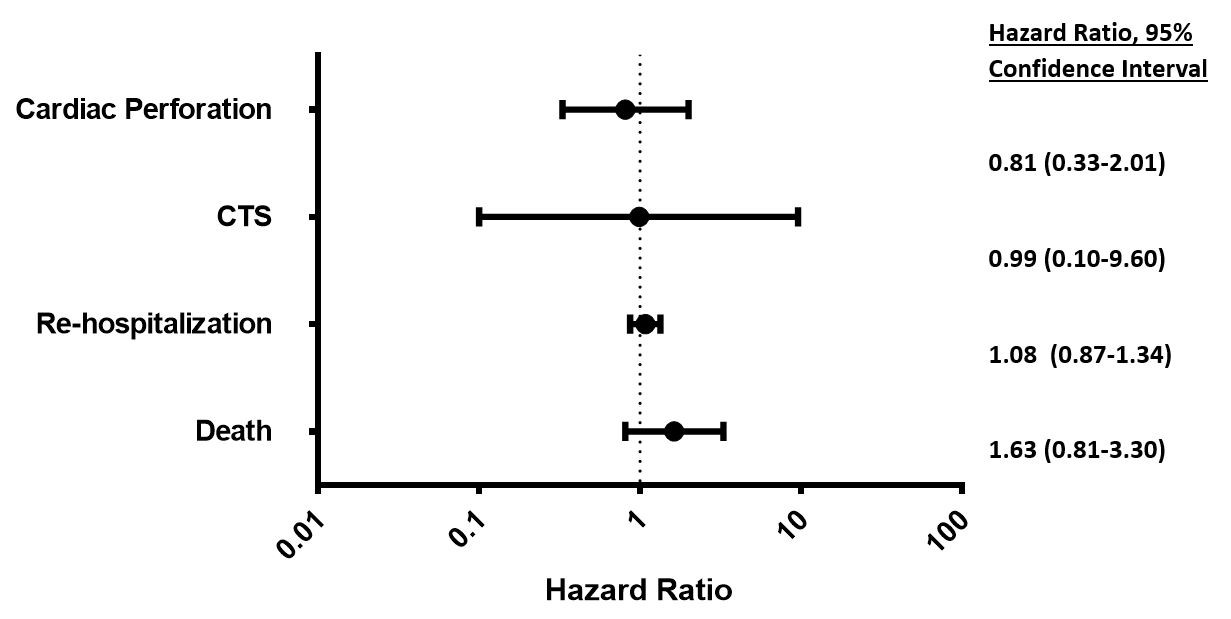Catheter Ablation of AF With and Without On-Site Cardiothoracic Surgery
Introduction
Catheter ablation of atrial fibrillation (AF) is a common procedure that reduces AF burden, improves quality of life,1 and may reduce mortality in certain patients, such as those with heart failure.2,3 Pericardial tamponade is a rare but potentially life-threatening complication of AF ablation.4 Although pericardiocentesis, which can be performed emergently by an electrophysiologist, is often sufficient for treatment, cardiothoracic surgery (CTS) is sometimes required for definitive management.5,6 The expanding role for AF ablation with an overall increasing AF burden in an aging population has resulted in this procedure being performed at more institutions, including smaller hospitals without CTS back-up. There is currently controversy and disagreement regarding whether AF ablation can safely be performed at hospitals without CTS.
Decreasing Rates of Cardiac Perforation With AF Ablation
Cardiac perforation is the most common fatal complication attributed to AF ablation.7 Historically reported rates of cardiac tamponade have ranged between 0.2% and 5%,1 although a recent systematic review including 83,263 patients reported an incidence rate of ~1%.4 Although cardiac tamponade is often diagnosed intraprocedurally, delayed tamponade has long been recognized as a clinical entity.8 A recent Canadian study suggested that more than half of all post AF ablation tamponade may be diagnosed after hospital discharge.9 The most recent study of cardiac perforation (which used Medicare claims data) reported a 0.67% rate of cardiac perforation, and approximately three quarters of these initial diagnoses were made during the index hospitalization.10 Although the rate of perforation observed in this recent study10 was lower than expected, particularly given the older patient population in this study, these results are consistent with the widely observed trends of overall improvements in AF ablation safety. These results are notable in light of a previous analysis of Medicare beneficiaries undergoing AF ablation from 2007 to 2009 that demonstrated a 1.7% rate of hemopericardium requiring intervention.11
Management of Cardiac Perforation
Emergent subxiphoid pericardiocentesis and reversal of anticoagulation is the preferred initial treatment for cardiac tamponade in the setting of AF ablation.1 Although surgical intervention is sometimes required for definitive management of perforation,5,6 the rate and nature of surgical intervention after initial pericardiocentesis is not well described. In a report of 40 cases of tamponade from 3 academic institutions, no patients required surgery.12 In another single-center study of 17 cases of tamponade, no patients required cardiac surgery, and 15 patients had their anticoagulation restarted within 12 hours.13 In a report from the Mayo Clinic, 17 patients with tamponade after AF ablation underwent pericardiocentesis with improvement in hemodynamics; however, 2 patients eventually required surgical repair due to ongoing pericardial drain output.5 In a survey-based study of 34,943 patients undergoing AF ablation, tamponade occurred in 0.9% of patients; treatment of tamponade was via pericardiocentesis in 84% of patients, pericardiocentesis then surgery in 15% of patients, and surgery only in 1% of patients.6 The rate of need for cardiac surgery in this large survey (with 289 cases of tamponade) is higher than the aforementioned smaller studies and the more recent study10 in which 5 of 464 patients with perforation underwent cardiac surgery.
Central to the controversy regarding performance of AF ablation at hospitals without on-site CTS is whether emergent pericardiocentesis is consistently able to stabilize hemodynamics to the point where, if needed, a patient can be transferred to second hospital with on-site CTS. The sufficiency of pericardiocentesis as a temporizing measure in this setting is likely complex related to several factors including severity of the primary injury, incidental cardiac puncture during pericardiocentesis, promptness of treatment, and a patient's overall cardiovascular reserve. Transfer time to a hospital with CTS may be an important determinant of the safety of performing AF ablation that needs further study. However, the relative rarity of cardiac tamponade requiring CTS after AF ablation (<0.1% in the most recent study10) represents a major impediment for designing an adequately powered clinical trial to definitively answer the question of whether on-site CTS is required and/or optimal.
Outcomes of AF Ablation With and Without On-Site Cardiac Surgery
Due to the paucity of data on outcomes of AF ablation with and without on-site cardiac surgery, using Medicare claims data, we recently studied 68,781 patients with AF 65 years and older undergoing ablation.10 Two percent of patients (n = 1,348) were ablated at a hospital without on-site cardiac surgery (14% of all hospitals in this study). The rate of cardiac perforation was 0.67%; 86% of patients with hemopericardium underwent pericardiocentesis, and 1.1% underwent cardiac surgery (Figure 1). All deaths after cardiac perforation occurred in patients who underwent AF ablation at a hospital with on-site cardiac surgery. In propensity-matched analyses, the presence of on-site cardiac surgery was not associated with outcomes including death, use of cardiac surgery, or re-hospitalization (Figure 2). Among patients in the matched cohort who experienced cardiac perforation (n = 28), no patients underwent CTS, and only 1 patient died within 30 days.
Figure 1
Figure 2
PCI With and Without On-Site Cardiac Surgery: Déjà Vu?
The controversy regarding AF ablation is similar to historical controversy over whether percutaneous coronary intervention (PCI) could safely be performed at hospitals without on-site CTS. Initial observational studies demonstrated conflicting results, with some studies suggesting PCI without on-site CTS was safe14,15 and others suggesting that this practice may be associated with excess mortality.16 Subsequently, two large randomized trials were conducted, and both demonstrated that among selected patients, PCI could be performed safely at hospitals without on-site CTS.17,18 It should be noted that the hospitals without on-site CTS in both studies had a formal relationship with a nearby hospital with on-site CTS, and often both hospitals were part of the same hospital system. Operators in both studies were high-volume interventionists, and many performed PCI at hospitals with and without on-site CTS; it has been suggested that procedural volume and working at a hospital with on-site CTS may be important factors contributing to the safety of PCI without on-site PCI.19 It is reasonable to hypothesize that many of the factors that appear to have optimized the safety profile of PCI without on-site CTS may similarly influence the safety profile of AF ablation without on-site CTS.
Guidelines
Although the topic of on-site CTS at the time of AF ablation has been mentioned in guideline and accreditation documents, formal recommendations and requirements are somewhat vague, likely reflecting an overall limited evidence base. The 2017 HRS/EHRA/ECAS/APHRS/SOLAECE expert consensus statement on catheter and surgical ablation of AF does not explicitly mandate on-site CT surgery, but rather states that AF ablations "should only be performed in hospitals equipped or prepared to manage these types of emergencies with access to emergency surgical support when required."1 The Intersocietal Accreditation Commission document on electrophysiology laboratory accreditation states that "emergency cardiovascular surgical support must be immediately available in case of life threatening bleeding complications from the extraction of chronic device leads and complex mapping/ablation procedures, particularly those requiring pericardial access."20 However, the document does not provide a definition of complex mapping/ablation (aside from mapping and ablation within the pericardial space) and allows that "for all other procedures, a facility must have a protocol in place for transferring the patient(s) to a tertiary facility."
Summary
In the setting of improved safety of AF ablation and increasing procedural demand given an aging population and expanding indications, AF ablation is being performed at hospitals without on-site cardiac surgery. Current guidelines overall allow for physician discretion regarding performing AF ablation at hospitals without on-site cardiac surgery, and a recent, large observational study suggested that this practice may be safe in appropriately selected patients. Additional research is required to better define the patient, physician, and health system characteristics that contributed to the observed low risk of performing AF ablation at hospitals without on-site cardiac surgery.
References
- Calkins H, Hindricks G, Cappato R, et al. 2017 HRS/EHRA/ECAS/APHRS/SOLAECE expert consensus statement on catheter and surgical ablation of atrial fibrillation. Heart Rhythm 2017;14:e275-e444.
- Marrouche NF, Brachmann J, Andresen D, et al. Catheter Ablation for Atrial Fibrillation with Heart Failure. N Engl J Med 2018;378:417-27.
- Di Biase L, Mohanty P, Mohanty S, et al. Ablation Versus Amiodarone for Treatment of Persistent Atrial Fibrillation in Patients With Congestive Heart Failure and an Implanted Device: Results From the AATAC Multicenter Randomized Trial. Circulation 2016;133:1637-44.
- Gupta A, Perera T, Ganesan A, et al. Complications of catheter ablation of atrial fibrillation: a systematic review. Circ Arrhythm Electrophysiol 2013;6:1082-8.
- Bunch TJ, Asirvatham SJ, Friedman PA, et al. Outcomes after cardiac perforation during radiofrequency ablation of the atrium. J Cardiovasc Electrophysiol 2005;16:1172-9.
- Michowitz Y, Rahkovich M, Oral H, et al. Effects of sex on the incidence of cardiac tamponade after catheter ablation of atrial fibrillation: results from a worldwide survey in 34 943 atrial fibrillation ablation procedures. Circ Arrhythm Electrophysiol 2014;7:274-80.
- Cappato R, Calkins H, Chen SA, et al. Prevalence and causes of fatal outcome in catheter ablation of atrial fibrillation. J Am Coll Cardiol 2009;53:1798-803.
- Cappato R, Calkins H, Chen SA, et al. Delayed cardiac tamponade after radiofrequency catheter ablation of atrial fibrillation: a worldwide report. J Am Coll Cardiol 2011;58:2696-7.
- Samuel M, Almohammadi M, Tsadok MA, et al. Population-Based Evaluation of Major Adverse Events After Catheter Ablation for Atrial Fibrillation. JACC Clin Electrophysiol 2017;3:1425-33.
- Friedman DJ, Pokorney SD, Khanna R, et al. Catheter Ablation of Atrial Fibrillation With and Without On-Site Cardiothoracic Surgery. J Am Coll Cardiol 2019;73:2487-9.
- Piccini JP, Sinner MF, Greiner MA, et al. Outcomes of Medicare beneficiaries undergoing catheter ablation for atrial fibrillation. Circulation 2012;126:2200-7.
- Latchamsetty R, Gautam S, Bhakta D, et al. Management and outcomes of cardiac tamponade during atrial fibrillation ablation in the presence of therapeutic anticoagulation with warfarin. Heart Rhythm 2011;8:805-8.
- Lin T, Bai R, Chen YW, et al. Periprocedural anticoagulation of patients undergoing pericardiocentesis for cardiac tamponade complicating catheter ablation of atrial fibrillation. Int Heart J 2015;56:56-61.
- Kutcher MA, Klein LW, Ou FS, et al. Percutaneous coronary interventions in facilities without cardiac surgery on site: a report from the National Cardiovascular Data Registry (NCDR). J Am Coll Cardiol 2009;54:16-24.
- Singh M, Holmes DR Jr, Dehmer GJ, et al. Percutaneous coronary intervention at centers with and without on-site surgery: a meta-analysis. JAMA 2011;306:2487-94.
- Wennberg DE, Lucas FL, Siewers AE, Kellett MA, Malenka DJ. Outcomes of percutaneous coronary interventions performed at centers without and with onsite coronary artery bypass graft surgery. JAMA 2004;292:1961-8.
- Aversano T, Lemmon CC, Liu L; Atlantic CPORT Investigators. Outcomes of PCI at hospitals with or without on-site cardiac surgery. N Engl J Med 2012;366:1792-802.
- Jacobs AK, Normand SL, Massaro JM, et al. Nonemergency PCI at hospitals with or without on-site cardiac surgery. N Engl J Med 2013;368:1498-508.
- Tomoda H. PCI at hospitals with or without on-site cardiac surgery. N Engl J Med 2013;369:392.
- The IAC Standards and Guidelines for Cardiac Electrophysiology Accreditation (Intersocietal Accreditation Commission website). 2019. Accessed July 17, 2019. Available at https://www.intersocietal.org/ep/standards/IACCardiacEPStandards2019.pdf.
Keywords: Arrhythmias, Cardiac, Pericardiocentesis, Cardiac Tamponade, Pericardial Effusion, Atrial Fibrillation, Quality of Life, Catheter Ablation, Cardiac Surgical Procedures, Heart Injuries, Heart Failure, Hospitalization, Medicare, Hemodynamics, Cohort Studies, Consensus, Emergencies, Percutaneous Coronary Intervention, Accreditation, Pericardium, Electrophysiology, Tomography, X-Ray Computed
< Back to Listings


